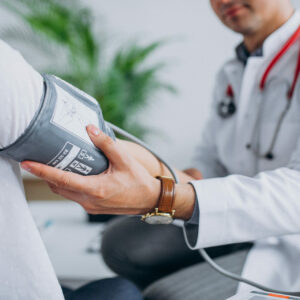Warning Signs of Postpartum Depression


Some signs and symptoms of postpartum depression include:
- Feeling sad or depressed
- Loss of interest in activities you used to enjoy
- Changes in your appetite
- Trouble sleeping or sleeping too much
- Loss of energy
- Inability to sit still, pacing, handwringing, etc. to the point it’s noticed by others
- Feeling worthless or guilty
- Difficulty concentrating or making decisions
- Thoughts of death or suicide
- Crying for “no reason”
- Indifference towards the baby or not feeling bonded to the baby
- Feeling very anxious about or around the baby
- Feeling like a bad mother
- Fear of harming the baby or yourself
To be diagnosed with postpartum depression, a new mother would need to have several of these symptoms, and postpartum depression is not to be confused with the “baby blues.” Up to 70 percent of women experience the “baby blues,” and this is a condition that may only last for a week or two (compared to several months in some cases of postpartum depression). The “baby blues” should not interfere with daily activities, although you may experience symptoms like crying for no reason, irritability, restlessness, and anxiety. Unless these feelings become more severe and/or last for longer than two weeks, this condition does not require medical attention and should resolve on its own without treatment.
If you are experiencing symptoms of postpartum depression, don’t dismiss them as a normal part of motherhood. Treatment is essential for postpartum depression, so it’s important to reach out to your provider and tell them what you’re going through.
https://www.psychiatry.org/patients-families/postpartum-depression/what-is-postpartum-depression
Managing High Blood Pressure


Some lifestyle changes you can make to lower your blood pressure include:
- Exercise regularly. 150 minutes of aerobic exercise (such as walking, jogging, cycling, swimming, or dancing) each week can lower your blood pressure by a significant amount.
- Eat a healthy diet. Following a heart healthy diet (one that is rich in whole grains, fruits, vegetables, and low-fat dairy products and low in saturated fat and cholesterol) can lower your blood pressure by up to 11 mm Hg.
- Lose extra weight. Blood pressure often increases as weight increases, so losing even a small amount of weight if you’re overweight or obese can help reduce your blood pressure. And the good news is, if you’re exercising and eating a healthier diet to lower your blood pressure, those steps can also help you lose the extra pounds too.
- Reduce your sodium. While the effect of sodium intake can vary from person to person, there is evidence to suggest that even a small reduction can make a big impact. Eating fewer processed foods and avoiding extra salt with meals is key to this step, but cut back gradually if this step seems overwhelming.
- Limit your alcohol. Drinking alcohol in moderation (drinking about a drink a day for women and two drinks a day for men) can actually lower your blood pressure. However, if you drink more and more frequently, it can have the opposite effect and raise your blood pressure by several points.
- Quit smoking. Every time you smoke, your blood pressure increases for several minutes after you finish. Quitting helps your blood pressure return to normal levels and can also reduce your risk of heart disease and improve overall health.
- Cut back on caffeine. The effect caffeine has on blood pressure in people who regularly drink it is still debated. To see if it raises your blood pressure, take your blood pressure within 30 minutes of drinking a caffeinated beverage to see if it is higher. If it is, you may want to switch to drinks with lower caffeine levels.
- Reduce your stress. Easier said than done, we know, but chronic stress can contribute to high blood pressure. Consider what might be causing you unnecessary stress and try to work on a plan to try to lower it. Learning to say no and set boundaries can have a big impact on lowering your stress and allow for more time to relax and spend time on activities you enjoy.
- Monitor blood pressure. If you have been diagnosed with high blood pressure, it’s important to check your blood pressure at home often. This can help you to determine if the lifestyle changes you’re making are working. Seeing your healthcare provider regularly and discussing your pressure levels is also a key step in effectively monitoring your blood pressure.
- Get support. Making lifestyle changes like eating healthier, exercising more, limiting alcohol and sodium, and reducing stress can be difficult to undertake alone. Seek out encouraging and supportive family and friends and consider joining a support group of like minded people.
https://www.mayoclinic.org/diseases-conditions/high-blood-pressure/in-depth/high-blood-pressure/art-20046974
Instant Pot Chicken Parmesan


- 1 tablespoon olive oil
- ½ small onion, chopped
- 2 cloves garlic, minced
- 1 28 ounce can crushed tomatoes
- 1 tablespoon tomato paste
- 2 teaspoons sugar
- Pinch of red pepper flakes
- Salt and black pepper
- 4 chicken cutlets
- ½ teaspoon Italian seasoning
- ½ teaspoon sweet paprika
- 2 tablespoons grated parmesan
- 4 slices low-moisture, part-skim mozzarella
- 6 basil leaves, cut into strips
Directions:
Step One: Turn the Instant Pot® to the low saute setting. Add the oil and heat until it is simmering but not smoking. Add the onion and garlic and cook, stirring occasionally, until the onions just begin to soften, 4 to 5 minutes. Stir in the crushed tomatoes, tomato paste, sugar, red pepper flakes, salt and a few grinds of black pepper, then turn the pot off.
Step Two: Season the chicken cutlets on both sides with the Italian seasoning, paprika, salt and a few grinds of black pepper and nestle them into the sauce, overlapping just slightly if needed. Follow the manufacturer’s guide for locking the lid and preparing to cook. Set to pressure cook, on high, for 2 minutes.
Step Three: After the pressure cook cycle is complete, follow the manufacturer’s guide for quick release and wait until the quick release cycle is complete. Careful of any remaining steam, unlock and remove the lid and turn the Instant Pot® off.
Step Four: Use tongs to reposition the chicken on top of the sauce if they have sunk. Sprinkle the tops of each cutlet with the Parmesan then place the mozzarella on top, tearing the cheese in half if needed to better cover the chicken. Place the lid back on and let sit until the cheese has melted, 3 to 4 minutes.
Step Five: Spoon the chicken and sauce onto a plate or platter and garnish with the basil.
https://www.foodnetwork.com/recipes/food-network-kitchen/healthy-instant-pot-chicken-parmesan-9488556






